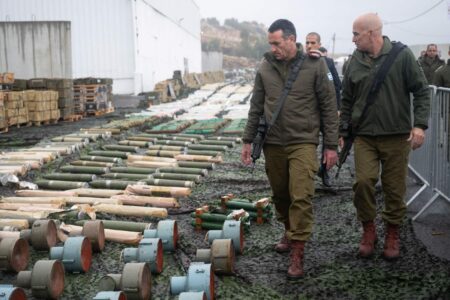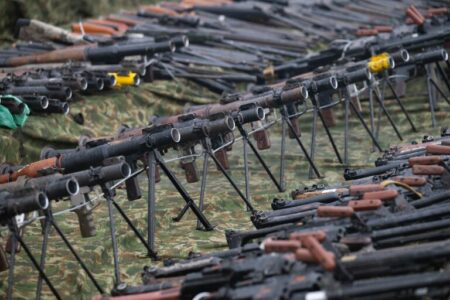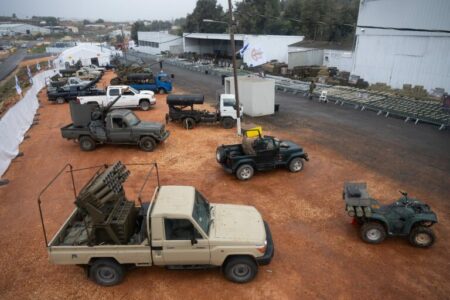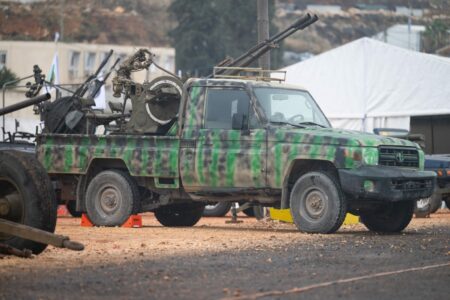The Israeli Defense Forces (IDF) continues to operate against Hezbollah in southern Lebanon and other parts of the country, taking advantage of the ceasefire brokered by the United States which entered into effect on November 27.
The ceasefire agreement does call for the withdrawal of Hezbollah from southern Lebanon. It also says that the group’s infrastructure in the region should be dismantled. However, it also calls on Israel to end its violations of Lebanon’s territory, which is yet to happen.
On December 25, Lebanon’s state media said that an Israeli strike targeted the Baalbek region in the east of the country before dawn.
The strike near the town of Tarya did not result in casualties, the state-run National News Agency reported. A Lebanese security source, speaking on condition of anonymity, said that the strike targeted “warehouses believed to belong to Hezbollah.”
On the same day, the IDF showcased loads of weapons which it claimed were captured from Hezbollah in southern Lebanon.
In all, the IDF says the display includes arms and other equipment from some 85,170 individual items captured from Hezbollah.
The weapons at the display include some 6,840 rocket-propelled grenades and anti-tank missiles, including 340 Russian-made Kornets, along with their launchers; 9,000 explosive devices and grenades; 2,250 unguided rockets and mortars; 2,700 assault rifles; 2,860 other guns including sniper rifles; and 60 anti-aircraft missiles.
The display also includes 20 Hezbollah vehicles captured by the IDF; 60,800 pieces of electronic equipment, communication devices, computers, and documents; and 300 pieces of surveillance equipment, including binoculars, according to the military.
The weapons and equipment were captured by Israeli troops during operations in over 30 villages in southern Lebanon since late September. Military officials say that some of the weapons that meet Israeli standards, such as the mortars, will be used by the IDF.
On December 27, Israel escalated against Lebanon. The IDF launched against what it said was infrastructure used by Hezbollah on the Syria-Lebanon border to transfer arms.
According to the military, Israeli Air Force fighter jets hit sites at the Janta crossing, located in the Beqaa Valley of eastern Lebanon.
“The Hezbollah terror organization uses civilian infrastructure to carry out terror activity and to transfer weapons, which are intended to be used to carry out terror attacks against Israeli citizens,” the military said.
Later on December 28, the IDF released footage from a tunnel belonging to Hezbollah’s elite Radwan force which was recently discovered and demolished in southern Lebanon.
The military said the 100-meter-long underground passage was used by Hezbollah to store numerous weapons, surveillance equipment, and other military gear. The tunnel also led to a Hezbollah command center, where the military said that it found rocket launchers used in previous attacks on Israel, alongside numerous explosive devices.
Recent Israeli operations in Lebanon led to speculations that the IDF won’t be withdrawing from the country after the end of the two-months ceasefire as agreed upon.
The United Nations peacekeeping force in Lebanon (UNIFIL) called on December 26 for a timely Israeli withdrawal from south Lebanon.
In a statement, UNIFIL voiced its concern over what it said was continued destruction by Israeli forces of residential areas, farmland and infrastructure in south Lebanon, deeming this a violation of UN Resolution 1701.
“UNIFIL continues to urge the timely withdrawal of the Israel Defense Forces and the deployment of the Lebanese Armed Forces (in place of Hezbollah) in southern Lebanon, alongside the full implementation of Resolution 1701 as a comprehensive path toward peace,” the statement said.
Responding to the station, the IDF said that it was looking into UNIFIL’s criticism and declined further comment for the time being.
On December 27, Israel said that the deadline for its troop withdrawal from southern Lebanon, stipulated in a cease-fire agreement, is “not a sacred date.”
The Israeli Public Broadcasting Corporation quoted unnamed Israeli security officials as saying:
“The two-month timeline for the withdrawal of Israeli forces from southern Lebanon is not a sacred deadline, and the implementation of the withdrawal depends on field developments.”
“The plans presented to the U.S. mechanism, which coordinates between the Israeli and Lebanese armies and UNIFIL (United Nations Interim Force in Lebanon), include gradual timelines based on steps taken by the Lebanese army,” the officials added.
They also stated that Israel had informed the U.S. that the withdrawal would only take place after the necessary conditions are met, without providing further details.
The broadcaster alleged that “Israel has monitored Hezbollah’s attempts to move personnel from Syria to Lebanon over the past two weeks.”
The agency also reported that “Israel has emphasized to the international community that it will not withdraw from southern Lebanon unless Hezbollah withdraws to the northern bank of the Litani River and the Lebanese army deploys along the border.”
Lebanese Prime Minister Najib Mikati responded on the same day by denying reports that Lebanon had been informed through intermediaries that Israel would not withdraw from southern Lebanon after the end of the ceasefire.
In a statement, Mikati’s media office emphasized: “This information is completely false.”
“The firm position that Mikati has conveyed to all relevant parties, including the U.S. and France, is that pressure should be exerted on Israel to withdraw from the Lebanese territories it occupied and stop its violations and hostile actions,” it said.
Overall, tensions remain high between Israel and Lebanon. The conflict with Hezbollah is not over yet, and while the group has tolerated IDF violations so far, this could change after the end of the ceasefire. On the other side, Israel is clearly trying to take advantage of the situation that emerged after the surprising fall of the Assad regime in Syria which left Hezbollah without a supply route.
MORE ON THE TOPIC:










all weapons and munition will be transferred to ukraine except some high value misiles like kornet atgm
even if israel wants to transfer such weaponry to ukraine, they have to assess to see if it’s worth it (money and politics). i don’t israel is in the habit of betting on a dying horse.
nah the jews are the dying horse – no future for that dying horse!
they wont “die ” until the usa/uk stop taking orders from tel aviv.
as israel runs both countries that wont be happening soon .
upvoted there for stating the obvious 👍
a year ago many said that about isreal vs the resistant axis. now it looks like the resistant axis is all gone and isreal rules supreme over the region. so why do you think it will be different in other regions?
bravo idf. keep up the good work.
nazi asshole
iranian assaholla idiot
more illiterate zionazi filth scribbling from his tranny rathole in occupied palestine.
“σιωνιστες-ναζι” ειναι προπαγανδα του σιωνισμου !! οπωσ και οι αντι-σημιτες !! δεν υπαρχουν !!!
γιατι τον λες “ναζι” ? επειδη οι “σιωνιστες” ειναι οι καλοι και οι “ναζι” οι κακοι ?? οι ναζι ηταν και ειναι οι απολυτοι εχθροι των σιωνιστων πολιτικα και θρησκευτικα !!!
zionazi filth wallowing in the blood of children and innocent.
iranian assholes crying and weeping. bye idiot.
why run? you afraid that you might get hurt?
you got the ‘drunken dimitri’ moniker too ?you hook noses are such unstable creatures. it’s the inbreeding, you can’t help it
get thee back shlomo satan and burn in hell
δεν υπαρχουν “σιων-ναζι”, ειναι σιωνιστικη προπαγανδα !!!
natural selection, darwinian fate, the law of the strong, may the best people win.
ο “δαρβινισμος” δεν αφορα στους εβραιους ειναι “φυλετικο και εθνικο συνονθυλευμα” !!!
still getting an influx of idf diaper dicks into your mental asylums ? you know, headbanging and loose bowel syndrome and all the other fun conditions.
that’s a lot of $$$.
war is business at some point.
omg it’s the most profitable business ever.
they should release the hostages that they kidnapped in oct 7th .
try to get some basic education. hezbollah is not hamas.
those zionist gangsters should release thousands of lebanese held hostage by the zionists for years.
how about no?
how bout zyklon b to your door?
θα λεγαμε ναι !!!
…και 10.000 παλαιστινιους !!!
nah, starve them to death to get one problem out of the way.
το κανουν ηδη, αλλα.. δεν φαινεται να το καταφερνουν !!!
the stooges will remain imprisoned until death, if i was hamas i would have punished them rather than treated them like normal prisoners.
οχι !! πρεπει να τους ανταλλαξουν με 10.000 φυλακισμενους παλαιστινιους !!!
βεβαιως, αφου οι κατοχικοι αποσυρθουν απο την γαζα !!!
maybe israel should withdraw back to the po river. after all most israelis are italian descent.
as far as i know, most israelis are ukrainian and russian jews from the ussr.
yep, that’s why putin is so careful of them. they have friends in moscow. rich, powerful ones, just like the u.s. has. just like every country in the west and most of the world has. sayanim are everywhere, thus pogroms throughout europe since how long? that also includes most arab states too…especially the gulf ‘arabs’. they make western spy shops look like the keystone kops…they are all infiltrated.
putin is an israel loving jew. he’s on top of the dung-pile, and yes, moscow and st petersburg would be the habitats of these thieves and carpetbaggers that looted soviet infrastructure. all he’s done is reigned in the most detestable, applying lipstick to the jew pig 🐖.
ο β.πουτιν ειναι κρυπτο-εθνικιστης πατριωτης !!
plus the odd polish psychopathic boof-headed animal
μπουουουου !!!
οικουμενικο,συνονθυλευμα ειναι, χωρις φυλη, χωρις εθνος !! θρησκευτικο !!
δεν εχουνκαταγωγη ! μονον θρησκεια εχουν !!
the zionazi filth is snickering now as it wages ussan tax cattle paid for terror wars in all directions. but wait..when the ussan dollah gets flushed how long will the rotten albatross of israhell survive the wrath boiling in the blood of the entire m.e? karma might come late but come it always does. meanwhile the moneyed zionazi$ are heading back to their former euro and ussan ghettos. nut’nyahoo has dodged a bullet like don chump (snicker) but more will be coming of that there is no doubt.
the iranian scums are snickering now as its axis of terror dwindling and defeated but wait..when the russian rubles get flushed how long will the rotten albatross of ayatolla assahola regime survive the wrath boiling in the blood of the entire m.e? karma might come late but come it always does. meanwhile the moneyed kremlin are heading back to their former old soviet ghettos. assahollah and putin has dodged a bullet like don chump (snicker) but more will be coming of that there is no doubt.
ευχες ???
and what tells you they wont control whatever comes after the dollar as they controled the pound sterling before the dollar?
“σιωνο-ναζι” = νεα σιωνιστικη προπαγανδα !!!
the joo is incapable of ever honoring anything it signs. history has shown that thousands of times as these neanderthals were expelled from every land they ever polluted. palestine will do the same of that there can be no doubt. the goyim dollah is all that keeps the cabal of filth lodged in palestine. flush the dollah and down the sewer goes the zionazi turd with it.
the iranian scums are incapable of ever honoring anything it signs. history has shown that thousands of times as these barbarian rapists are like a bubonic plague spreading death. palestine is a shithole and so does lebanese hezbollah and houthis will be next. the iranian petrol is all that keeps the cabal of filth lodged in tehran. flush the rubles and down the sewer goes the iranian turd with it.
the only shithole in the area is the kikenreich
ο “γιαχβε” μαζι σου !!!
thats useless and propaganda, surely thousands of weapons have been sent to lebanon after the fall of damascus.
🇷🇺=🏃♂️🤡 😆😆😆
🇮🇱 = 💩💩💩💩💩💩 . . heheheh
of course, ever trusted a jew, gullible fool. never trust the jews that since long has lost the right to be part of mankind. for the future of mankind, the jews must go – no one needs a jew and that applies to the mankind as a whole!
well the problem is the jews are the ones who descide who belongs to mankind and they have pointed thumbs down on iran, irak, syria, russia and china.
iran is untouchable for the jres without the help of the americ*unts and a few nukes. but to employ nukes would be the end of the jews and even massive use of nukes wouldn’t be enough. iran 1.8 million sqkm and 85 million inhabitants. the childmolesters in occupied palestine are at the most 10 million and they would have to live in the contaminated me so it must be a conventional war sonthey are f*cked even before they start!
so to repeat, the best for mankind is to exterminate them vermin asap to bring peace and tranquility to terra nostra! something the jews haven’t been able to provide in about 2000 years. headshots the best and quickest means!
δεν χρειαζεται εξοντωση.. αρκει η εκτοπιση τους σε εναν ερημο τοπο, ολοδικο τους, οπως προσπαθησε να κανη ο α.χιτλερ με την τελικη λυση, αλλα.. δεν τον αφησαν οι “αγγλο-σιωνιστες” !! και την πατησαμε ολοι !!!
they may have pointed their thumbs down but they’ll get other various useless gentile curs to go forward with attempting to implement their anti human behaviour.
δεν αισθανονται μερος της ανθρωποτητας ! το λενε !! ειναι ο “εκλεκτος λαος” του “γιαχβε” και ολοι οι λαοι, φυλες και εθνη, πρεπει ως κατωτεροι, να τους υπηρετουν !!!
the muslim world is on its last leg. soon they will all be pro zionist shills just like the christian world has become.
only god himself can put an end to zionism.
the jews are on their last inning. their accumulated stolen fortunes to be returned to mankind as the jews exit this world!
δεν θα μπορεσουν.. απεναντι τους εχουν την “μαννα-γη-φυση” !! υα τους συντριψη !!
so much armament and ammo of hezbollah left behind, why not evacuated at least the most valuable kornets, manpads and why the rest wasnt mined and blown up?
shlomos now in south lebanon and syria, but where is the guerilla resistance in a area full of armament?
also in the perfect urban gaza the resistance is only poor and weak.
arabs are a joke of fighters.
u.s. cease fire? you mean u.s. engineered rape of lebanon and hezbollah don’t you? lebanon will be rendered neutered if israel has it’s way and it looks like they’ve got a good start. if the lebanese think the zionists are done with them they are delusional. lebanon is slated to be absorbed by both israel and their partner turkey. they should have encouraged hezbollah to increase their attacks or declared war, as now israel has free rein…or haven’t they noticed?
υπερ-απλουστευεις !!
soon this phony one-way ‘cease-fire’ will be over. israel will attack lebanon from the east, where hezbollah is weakest. too bad they didn’t booby-trap all those weapons and take some scum down. trump will back them up and a real war will start. he will even go after the houthi’s, which will cost american’s ships and men. they have refrained from sinking them, but that’s going to change.
the gulf states will enforce a blockade and starve the nation.
μην μπερδευεις το επιθημητο με το πραγματικο !!!
it will carry on until nearly person alive understands the evil they have allowed to transpire for so many years. that is the nature of man, they will not try to listen but they will learn the hard way instead.
brainwashed populations will always support their own demise through corrupt leadership, everyone pays the price. the only solution is hearts and minds, and complete eradication of the mind control politicians and their henchmen. .
σωστος !!!
δυστυχως.. σωστος !!!
real or chabad gtp news? whole social media is in bot mode likely since we are close to communication black out. large liar models making us all wonder. showbusiness is an extension of the jewish religion like lennon before mi6 had him blown away. moral isn’t low enough to turn shabbo fa**ot like the morrocan boys….
the sooner they surrender unconditionally and wholeheartedly, the fewer of them the idf will have to shoot, but as long as a state of war exists, israel will keep stacking them up. and no one will cry.
λες..οι προσευχες σου να εισακουσθουν απο τον “γιαχβε” ??